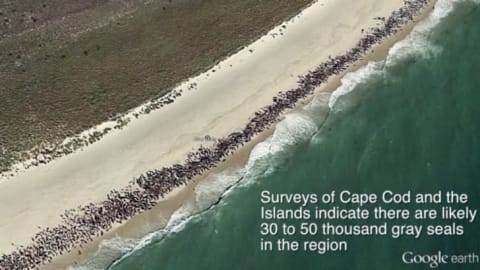Survey Says: Gray Seals Are Back

Scientists have used Google Earth to count New England’s gray seals, and the news is good: The digital survey spotted tens of thousands of animals, far more than previously estimated. The researchers published their findings in the journal Bioscience.
The same features and behaviors that help gray seals survive—their snow- and ice-colored coats, along with their strong swimming skills—can also make them hard for scientists to find. It's important that we find them, and not just because they're so very cute.
Accurate surveys of wildlife populations are crucial not only to scientific understanding of how the world works but also in creating policy measures that will help keep that wildlife safe.
Historically, researchers have done their counting the old-fashioned way: first on foot, seal by seal, then by motor vehicle, then by flying planes over the hauled-out seal families as they lay on the beaches and ice.
Previous aerial surveys of New England populations spotted about 15,000 seals off the southeastern coast of Massachusetts. But scientists were pretty sure they were overlooking at least a few animals.
For a different perspective, they tapped into Google Earth and scoured the beaches, the ice, and the frigid waters where the seals spend so much of their time. They overlaid these images with radio tracking data, and the combination provided a far fuller view of the seals’ world.

Reviewing the results, the researchers discovered that the aerial surveys had, in fact, missed a few animals. All right, more than a few—more like 15,000 to 35,000. The Google Earth/radio data survey easily doubled and could triple previous estimates.
“Computer-based assessments of seal populations such as this hold great promise in terms of accuracy and repeatability,” study co-author David W. Johnston of Duke University said in a statement.
“This is a conservation success that should celebrated.”